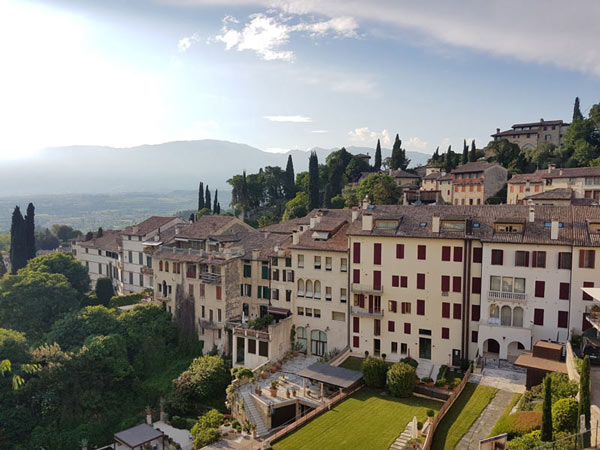Asolo, in the Veneto region of north-eastern Italy, is in many ways a town that time forgot. Nestled on sweetly-wooded hillsides under an austere fortress, the delightful citadel of a Renaissance queen still basks in golden charm: sunlight warming faded frescoes above arcaded streets, church bells ringing across jumbled rooftops, and the statues and turrets of historic villas peeping from between trees and rose-filled gardens. Of course the modern world impinges, but if you can overlook the cars filing through narrow lanes or parked in the piazza, Asolo still has very much the air of a town where the shades of former residents Robert Browning and Freya Stark might repose to this day, sipping tea and writing. Like Taormina and Fiesole, this hill town with its refreshing breezes was a favoured resort of rich and cultured villa-building foreigners and Italians. Unlike its better-known rivals, however, Asolo offers neither beaches nor easy transport links, so still maintains its exclusivity, and the seductive atmosphere of a world apart.
> Accommodation in Asolo – availability and bookings (detailed recommendations below)
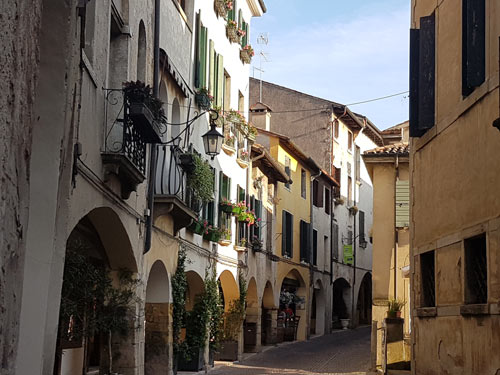
Visiting Asolo
Present-day Asolo has a comfortable and prosperous atmosphere, appealing to well-heeled Italians, expats and in-the-know travellers. The small selection of hotels in the town includes two modest five-star hotels, quirky high-end boutiques are set unobtrusively along an arcaded pavement, and the tourism here is discreet and well-mannered. Asolo is ideal for a low-key weekend idyll immersed in the peace and beauty of this little hill town, or perhaps shopping at the monthly open-air antiques market.
Although the town does have several specific tourist sights, described below, the atmosphere, views and general charm are a bigger draw for most visitors: this is a ‘lifestyle’ destination. You can live extremely well here, enjoying rich local food, fine local wines – including Prosecco from the surrounding region – taking a stroll to admire the views, and then retiring to the comfort of a high-standard hotel. It’s easy to see the town’s main charms in a day, though to appreciate the laid-back atmosphere and good dining, you should consider staying at least one night. I spent twenty-four hours in Asolo and I enjoyed leisurely sightseeing, strolling and meals. But although I had ‘done’ the town’s most obvious tourist attractions, I would have loved to stay on, sampling more restaurants and bars, settling into Asolo’s harmonious version of la dolce vita, and taking trips further afield to tour the villas and sights of the wider area. If you drive, hire a driver, or are happy reading, sketching or taking photographs, it would be seductively easy to settle into a long and pleasurable stay in this classy Italian idyll.
I visited mid-week in May, when the weather was warm and the town was quiet. May, June and September would probably be the best months to visit for warm temperatures without crowds, while autumn leaves add colour to the scenery later in the year. Asolo’s museum and fortress are only open at weekends at the time of writing. On Sundays when the centre is pedestrianised there are often events and entertainment, and on the second Sunday of every month the town’s historic lanes are taken over by a large antiques market. The town has a tourist information office with a useful website including opening times, walking itineraries and transport information in Italian and English.
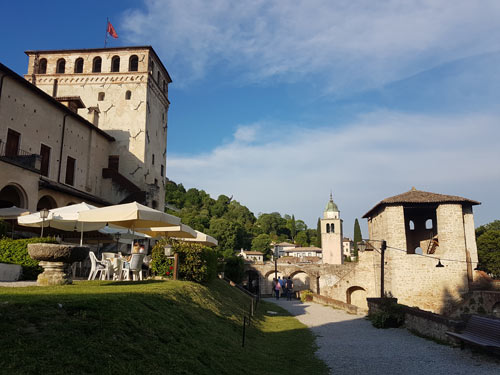
A history of courtly leisure
Asolo as a venue for whiling away the time pleasurably goes back many centuries. There was a Roman town here which held a theatre and a spa. After spending the Middle Ages as the base of a succession of warring dynasties, in 1489 the town was presented to Caterina Cornaro, Queen of Cyprus, for a kind of gilded exile. A young Venetian noblewoman who was married to the King of Cyprus for political purposes, and is one of the only women to feature in Venice’s history books, Caterina inherited the crown and was then ‘persuaded’ to give the island to Venice in return for a life of luxury in Asolo. Here the queen gathered a cultivated court around her, one where poet and scholar Pietro Bembo is said to have coined the expression asolando (asolo-ing), defined much later by Asolo-lover Robert Browning as “to disport in the open air, amuse one’s self at random.” Queen Caterina Cornaro and Robert Browning are two of Asolo’s most celebrated residents, evoked frequently locally, and commemorated in street names. Another is Dame Freya Stark (1893-1993), the British writer and traveller. As well as the buildings associated with these figures, visitors can learn more about them and their connections with Asolo in the town’s museum.
Things to see and do in Asolo
If you’re interested in Asolo’s history and sights, the best time to visit is at the weekend, when the museum and Rocca (a ruined fortress) are mostly likely to be open. There is a helpful tourist information office in the heart of town, and the tourist board website can be useful for advance planning – both will provide the latest opening times, maps and walking itineraries.
Paintings, mementoes and other reminders of Asolo’s long history can be seen in the town museum, the Museo Civico, next to the tourist office in Asolo’s principal piazza, Piazza Garibaldi. Exhibits include portraits of Caterina Cornaro and the Stanza di Freya, an immersive introduction to the world of Freya Stark. Facing the museum entrance, and open daily, is Asolo’s cathedral, Santa Maria Assunta, a modestly imposing and ancient building, where the highlights are an altarpiece by Lorenzo Lotto (on the left wall) and a 15th-century stone font presented by Caterina Cornaro. Lotto’s painting is a relatively traditional altarpiece with two saints alongside the Virgin in Glory, who floats above a rural village scene. The mountainous background includes a hilltop village reminiscent of the Veneto region. Unusually, though, this Madonna looks middle-aged, her face a bit jowly and double-chinned; it’s thought this is a representation of Caterina Cornaro. Other paintings in the church include a 1488 altarpiece of St Jerome attributed to Sebastiano Bastiani (I haven’t found verification but believe this may be the same artist as the Lazzaro Bastiani who painted scenes of the saint now in the Accademia Gallery in Venice).
Piazza Garibaldi is the heart of Asolo and a wonderfully picturesque spot, whichever way you turn, from elegantly aged and frescoed buildings to the focal point, Fontana Maggiore, a fountain topped by a Venetian winged lion. Facing the fountain are the tables of Caffè Centrale, where locals once plotted to assassinate Napoleon, and where nowadays visitors and locals can sit to watch the world go by with a drink on the table in front of them. In a wall at the back of the large open space above the fountain, used as a car park, is a gateway opening onto the ‘Bot’, a tunnel once serving as an aqueduct which carried water to Roman baths nearby and which continued to serve the town for its water supply for centuries, with the system expanded in the Middle Ages.
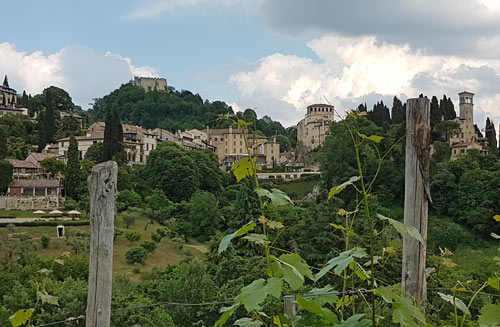
High on a wooded hill overlooking the town is the Rocca, a stone fortress dating to the 12th century. Although open only at weekends (and closed indefinitely for restoration at the time of writing), it is still worth the climb up to the hilltop to see the views across to the Dolomites, peer in the gateway at the bare ruins, and maybe enjoy a picnic. The route ascends from the Albergo al Sole, through an old gateway alongside a former convent and then up a stepped footpath. For a longer and pleasant stroll, you can return to town around the other side of the hill, following Via Rocca, a little lane which winds down through meadows and past villas into the lower slopes of Asolo. Just below the road into town, the historic and deconsecrated church of San Gottardo is among the sights. Look out, too, for Villa Freya, the home of Freya Stark, and Casa la Mura, built onto the town walls, where Robert Browning wrote Asolando. At the lower end of Via Browning, a little drinking fountain, the Fontanella Zen, is another of Asolo’s landmarks and offers welcome refreshment to new arrivals who’ve hiked or cycled up the hill into town.
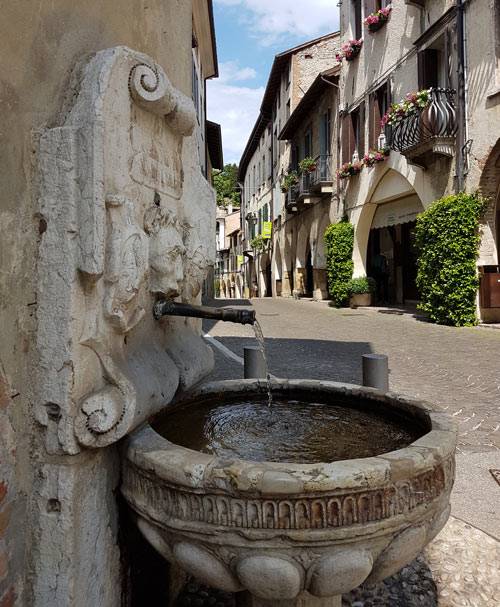
Asolo describes itself as the ‘City of a Hundred Horizons’ because of the many vistas on offer in and around the town. Taking time to stroll around the historic central lanes, and exploring further afield on foot is continually interesting thanks to the variety of views, from close-up roses tumbling over garden walls to the romantic silhouettes of villa turrets and cypresses on hilltops and beyond vineyards.
In the heart of Asolo is the Castello della Regina, the Queen’s Castle. This was the setting for Caterina Cornaro’s elegant court, and a complete contrast to the bare fortress up on the hill above town. These castle buildings are mellow inside old defensive walls, with a little garden, outdoor café tables, play equipment for children, and short walkways on the historic walls, with wonderful views. This is a lovely place to relax and enjoy late afternoon sunshine or indulge in photo opportunities.
Another rewarding excursion on foot from the centre is along Via Canova. Heading downhill, this picturesque street leads through an archway topped by a red building where the great actress Eleanora Duse, another of Asolo’s celebrated residents, lived. Beyond, the road leads past the Villa Cipriani, once belonging to Robert Browning and later to the Guinness family and now a luxury hotel (worth visiting for afternoon tea or drinks in the garden, even if you’re not a guest) and on to the modest 14th-century church of Santa Caterina, home to some lovely frescoes. Taking the road which branches left at the church, explorers can make their way into the countryside past more spectacular villas and on to one of Asolo’s most curious buildings, the Casa Longobarda. This eccentric ‘Lombard House’ was built as his own residence by Caterina Cornaro’s architect and sculptor Francesco Graziolo, who died here in 1536. Via Sant’Anna on the left by the Casa Longobarda leads to Asolo’s panoramic cemetery, where travellers can visit the graves of Eleanora Duse and of Freya Stark. Along this walk you’ll have views of a fine 16th-century villa, Villa Contarini or degli Armeni. This private villa must be one of the most intriguing in Italy; it consists of two buildings, one north-facing and one south-facing, on either side of a small hill, connected by a tunnel running through the hill.
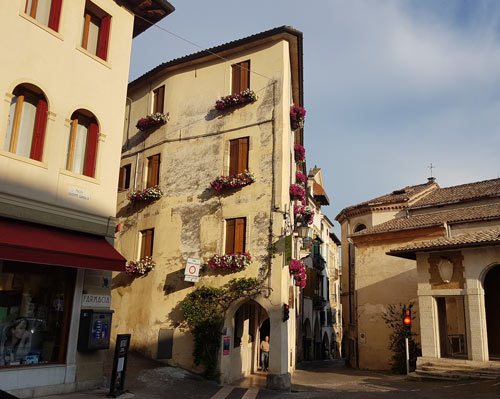
Eating, drinking and shopping
Asolo hosts a famous antiques market on the second Sunday of every month, a big event which takes place along the streets in the centre of town and attracts large numbers of visitors. Otherwise this isn’t really a big shopping destination, but if you are looking for food or a stylish impulse buy, there are a few opportunities to spend. Under the arcades of Via Browning are several boutiques selling clothes and accessories – mostly expensive, and chic. The town has a few food shops selling local food and drink, from Prosecco to pinza, a kind of speciality fruit cake. Travellers will find a few non-food souvenirs too, including cool graphic design products at Asile’s World (Via Browning 143) inspired by the town and its monuments.
A highlight among local wines is, of course, Prosecco, which can be sampled at the restaurants, bars and cafés in town as well as on-the-spot at vineyards around the district. Theres’s a small but enticing choice of restaurants in Asolo, ranging from casual to formal in atmosphere. I ate extremely well on the beautiful terrace of the Albergo al Sole and at the atmospheric little Osteria al Bacaro which has a little outdoor seating area across the arcaded Via Browning.
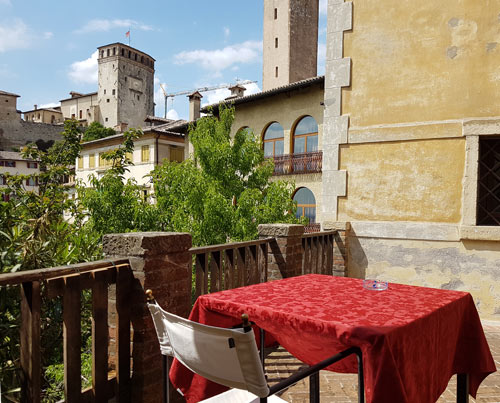
More things to see and do around Asolo
Asolo is an attractive base, if you have a car, for exploring this part of the Veneto region. It would be even possible to visit Venice from Asolo or vice versa, though if you’re interested in both towns, I’d recommend a two-centre holiday for an enjoyable trip of contrasts. Closer to Asolo are the charming towns of Treviso and Vicenza, both of which offer splendid architecture, art museums and restaurants and are good for a full day out, or a longer stay. Nearby picturesque towns for a few hours’ exploration include Bassano del Grappa, walled Cittadella, little Marostica, and Castelfranco Veneto, birthplace of the artist Giorgione, who left an altarpiece in the duomo. Interesting sights in the area include villas such as the Villa di Maser, designed by Palladio, with interior frescoes by Veronese and now part of a wine estate. At Possagno is a museum dedicated to sculptor Antonio Canova, who was born here, mostly containing plaster casts of his work, and nearby is the Tempio Canoviano, a grand church he designed. Architecture enthusiasts may also be interested in visiting the Tomba Brion, a striking modernist cemetery enclosure designed by architect Carlo Scarpa.
Where to stay in Asolo
The best places to stay in Asolo, if you want to do the town in real style, are its two classy five-star hotels. The more expensive and fancier of the two is Villa Cipriani, a short distance outside one of the town’s historic gateways, but still only a few minutes (uphill) walk to the centre. With terraced gardens, a pool and countryside views, this historic villa hotel is a good choice for a summer getaway. The Albergo al Sole, by contrast, is right in the heart of Asolo, overlooking the town’s main square. This hotel is also in a historic building, but has a more modern feel inside. Although there’s no garden, the hotel does have a restaurant terrace where guests can enjoy breakfast, lunch and dinner with excellent views. I really enjoyed my one-night stay, especially the fine dinner looking over the town as church bells rang, and a generous breakfast on the same terrace. Both hotels are small, fairly understated and the prices are generally not extortionate.
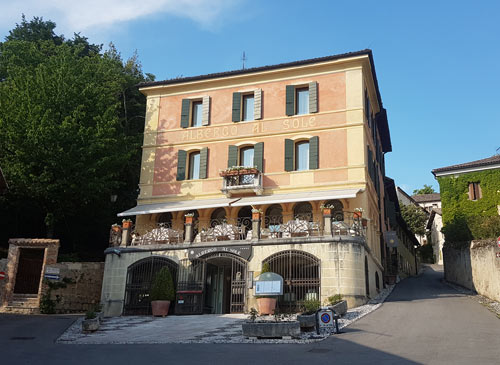
For atmosphere, staying in the historic town itself is definitely preferable. However, if you are on a driving tour, you may find it practical to stay close by, with easy road access. The three-star Hotel Asolo is near the main road close to Asolo and has good reviews. B&B Asolo Casapagnano is a popular B&B situated in a rural setting between Asolo and Bassano del Grappa, and offers bike rental and facilities. Back in the centre of Asolo, lower-priced options include the pretty and very central three-star Hotel Duse on Via Browning, and the B&B Asolando, which is a short walk from the historic centre. Self-catering options for an independent stay include the apartment Casa Bembo.
There are very few accommodation options in the historic centre of Asolo, in addition to a small number of hotels, B&Bs and agriturismo destinations dotted through the surrounding area. Consequently it’s a good idea to research your options and book well in advance of your travel, if you can. A fuller range of accommodation with availability can be found through the link below, while also supporting this website – a price guarantee ensures you will pay the cheapest prices available.
> Asolo hotels, B&Bs and apartments
Travel to Asolo
The idyll stops here. Unless you are driving, Asolo is a hassle to get to. Although annoying for visitors, this is also probably why the town has retained such a special and set-apart atmosphere. There is no railway station in the town, nor are there direct buses, at the time of writing, from any station into the centre of Asolo. Depending on where you’re coming from, you’ll probably need to take a train and two buses. If you have a car, you’ll get to Asolo more quickly, and be able to tour the attractive surrounding area, although driving still has its issues. Check ahead with your hotel about parking and traffic restrictions; Asolo centre is small, with narrow single-width streets controlled by traffic lights, and on Sundays is pedestrianised.
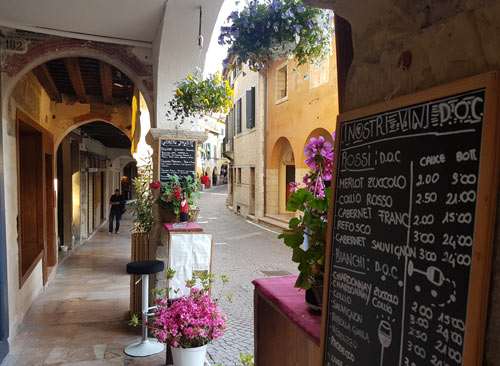
How to get to Asolo by public transport
If you are travelling purely by public transport, you’ll need to plan ahead and consult timetables. The buses which serve the area are mostly run by a firm called Mobilità di Marca. These stop on the plain at the foot of the hills, at a stop called Ca’ Vescovo. Here you can change to a shuttle bus which runs up the hill to the historic centre of Asolo. This is a minibus service run by a company called De Zen. Timetables are available from the tourist office website; a typical service is every half-hour, with a few longer gaps during the day.
There are bus connections to Ca’ Vescovo from several railway stations. The easiest connection is probably at Treviso station, where the bus station is close to the railway station; this is a long bus journey of about an hour. Castelfranco Veneto station is closer to Asolo, and has frequent direct trains to Mestre and Venezia Santa Lucia, the main railway station in Venice. However, here the buses operate from a bus station which is a short walk across town from the railway station. This may be fine if you are travelling light, for a day trip (and Castelfranco is a nice place to add in to your day’s sightseeing), but if you have luggage, you may want to take another bus to the bus station and change. These buses run from behind the railway station (take the underpass). Another station with bus access to Asolo is Montebelluna, but this station is served by fewer trains and most journeys will require a change of trains. Another drawback is that the bus routes serving Ca’ Vescovo are infrequent, with timetables which vary according to season, so more time can be lost if you don’t plan carefully.
The easiest way to reach Asolo without your own car is to take a taxi for at least the last leg of your journey, and this is what I’d recommend doing if you can fit it in your budget. Local hotels will help you organise a transfer, either from an airport (Treviso is the closest, followed by Venice Marco Polo) or from a railway station. My hotel quoted 120 euros from Venice Marco Polo, or 45 euros from Castelfranco Veneto station for a taxi transfer. There is a small taxi rank outside Castelfranco Veneto station, so if you’re travelling independently this saves time and effort on the final stage of your journey. After flying into Venice Marco Polo Airport I caught the ATVO bus to Mestre railway station, then a train to Castelfranco Veneto. My taxi ride from Castelfranco Veneto took approximately 20 minutes and cost 45 euros on the meter – plus my friendly taxi driver gave me some useful tips for eating out in Asolo.
Once you’ve reached Asolo, the historic centre can only really be explored on foot, and the slightly longer excursions described above are also pleasant walks. It is easy to spend one or two days here with no need for transport. For a longer stay, or exploring further afield, a car would be useful, although hotels can also organise private taxi tours and trips to nearby sights for those who’d prefer to pay someone else to do the driving.
Why visit?
Asolo is an excellent destination for an overnight stay or short break, or even a longer stay relaxing into the tranquil atmosphere. The historic centre is well-preserved and evocative of the town’s rich history and the varied and interesting people who have lived here over the centuries. It combines really well with Venice for a two-centre holiday enjoying these two contrasting faces of Italy; both very special, but one crowded and busy while the other is more of a hidden gem. It would be hard to spend a more pleasant few hours in Italy than wandering the picturesque lanes of Asolo and then enjoying a relaxing meal with local food and wine.
> Find somewhere to stay in Asolo
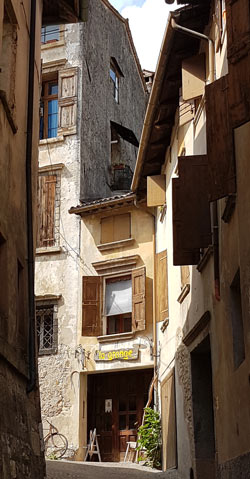
Useful external links
Veneto destinations
- Veneto region
- Abano Terme
- Asolo
- Bassano del Grappa
- Brenta Canal
- Caorle
- Castelfranco Veneto
- Chioggia
- Cittadella
- Concordia Sagittaria
- Conegliano
- Cortina d’Ampezzo
- Lido di Jesolo
- Malcesine
- Marostica
- Monselice
- Montegrotto Terme
- Padua
- Portogruaro
- Rovigo
- Sottomarina
- Treviso
- Venetian Lagoon
- Venice
- Verona
- Vicenza
- Veneto art & architecture itinerary
- Veneto villas – Vicenza: La Rotonda & Villa Valmarana ai Nani
- Veneto villas – Villa Pisani & Villa Foscarini Rossi, Strà
- Venice Airport
- Treviso Airport
